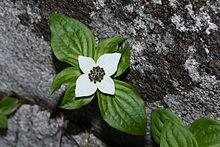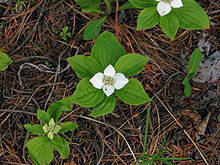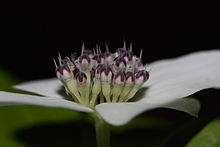- Cornus canadensis
-
Cornus canadensis Inflorescences of Cornus canadensis Scientific classification Kingdom: Plantae (unranked): Angiosperms (unranked): Eudicots (unranked): Asterids Order: Cornales Family: Cornaceae Genus: Cornus Subgenus: Chamaepericlymenum Species: C. canadensis Binomial name Cornus canadensis
L.Cornus canadensis (Canadian Dwarf Cornel, Canadian Bunchberry, Quatre-temps, or Crackerberry) is a herbaceous member of the Cornaceae (dogwood) family. It grows about 20–30 cm tall and bears tiny flowers a few millimetres across that form an inflorescence at the center of four white, petal-like bracts 3–4 cm diameter.
Each flower has highly elastic petals that flip backward, releasing springy filaments that are cocked underneath the petals. The filaments snap upward flinging pollen out of containers hinged to the filaments. This motion takes place in less than half a millisecond and the pollen experiences 800 times the acceleration that the Space Shuttle does during liftoff. The Bunchberry has one of the fastest plant actions found so far requiring a camera capable of shooting 10,000 frames per second to catch the action.[1]
Edible fruit of Cornus canadensis, Mount Baker-Snoqualmie National Forest
The fruits are edible with a mild flavour somewhat like apples. The large seeds within are somewhat hard and crunchy. Birds are the main dispersal agents of the seeds, consuming the fruit during their fall migration. In Alaska, bunchberry is an important forage plant for mule deer, black-tailed deer and moose, which consume it throughout the growing season.[2]
While distinctive as a species itself, the generic placement of these plants has differed in various botanical treatments. When the genus Cornus is taken broadly, as done here, this species is Cornus canadensis. However, if Cornus is treated in a narrower sense, excluding this species, it can instead be classified as Chamaepericlymenum canadense or as Cornella canadensis.[3][4]
Where bunchberry, a forest species, and Cornus suecica, a bog species, grow near each other in their overlapping ranges in Alaska, Labrador, and Greenland, they can hybridize by cross-pollination, producing plants with intermediate characteristics.[5]
Description
Cornus canadensis is a slow-growing perennial herbaceous subshrub growing 10–20 cm tall, generally forming a carpet-like mat. The above-ground shoots rise from slender creeping rhizomes that are placed 2.5–7.5 cm deep in the soil, and form clonal colonies under trees. The vertically produced above-ground stems are slender and unbranched. The leaves are oppositely arranged on the stem, but are clustered with six leaves that often seem to be in a whorl because the internodes are compressed. The leafy green leaves are produced near the terminal node and consist of two types: 2 larger and 4 smaller leaves. The smaller leaves develop from the axillary buds of the larger leaves. The shiny dark green leaves have 2 to 3 mm long petioles and leaf blades that are obovate. The blades have entire margins and are 3.5 to 4.8 cm long and 1.5 to 2.5 cm wide, with 2 or 3 veins and cuneate shaped bases and abruptly acuminate apexes. In the fall, the leaves have red tinted veins and turn completely red. Inflorescences are made up of compound terminal cymes, with large showy white bracts. The bracts are broadly ovate and 0.8 to 1.2 cm long and 0.5 to 1.1 cm wide, with 7 parallel running veins. The lower nodes on the stem have greatly reduced rudimentary leaves. In late spring to mid summer, white flowers are produced that are 2 mm in diameter with reflexed petals that are ovate-lanceolate in shape and 1.5 to 2 mm long. The calyx tube is obovate in shape and 1 mm long covered with densely pubescent hairs along with grayish white appressed trichomes. Stamens are very short, being 1 mm long. The anthers are yellowish white in color, narrowly ovoid in shape. The styles are 1 mm long and glabrous. Plants are for the most part self-sterile and dependent on pollinators for sexual reproduction. Pollinators include bumblebees, solitary bees, beeflies, and syrphid flies.[6] The fruits look like berries but are drupes. The drupes are green, globose round in shape, and turn bright red at maturity in late summer; each fruit is 5 mm in diameter and contains typically one or two ellipsoid-ovoid shaped stones.
Cornus canadensis is a mesophytic species that needs cool, moist soils. It is native to northern China, far eastern Russia, Japan, and North America in montane and boreal coniferous forests, where it is found growing along the margins of moist woods, on old tree stumps, in mossy areas, and amongst other open and moist habitats.
References
- ^ Edwards J, Whitaker D, Klionsky S, Laskowski MJ (2005). "Botany: a record-breaking pollen catapult". Nature 435 (7039): 164. doi:10.1038/435164a. PMID 15889081.
- ^ Hanley, Thomas A.; Cates, Rex G.; Van Horne, Beatrice; McKendrick, Jay D. 1987. Forest stand-age related differences in apparent nutritional quality of forage for deer in southeastern Alaska. In: Provenza, Frederick D.; Flinders, Jerran T.; McArthur, E. Durant, compilers. Proceedings--symposium on plant-herbivore interactions; 1985 August 7–9; Snowbird, UT. Gen. Tech. Rep. INT-222. Ogden, UT: U.S. Department of Agriculture, Forest Service, Intermountain Research Station: 9-17.
- ^ Eyde, R. H. 1987. The case for keeping Cornus in the broad Linnaean sense. Systematic Botany. 12(4): 505-518.
- ^ Eyde, Richard H. 1988. Comprehending Cornus: puzzles and progress in the systematics of the dogwoods. Botanical Review. 54(3): 233-351.
- ^ Neiland, Bonita J. 1971. The forest-bog complex of southeast Alaska. Vegetatio. 22: 1-64.
- ^ Barrett, Spencer C.; Helenurm, Kaius. 1987. The reproductive biology of boreal forest herbs. I. Breeding systems and pollination. Canadian Journal of Botany. 65: 2036-2046.
External links
- NCRS: USDA Plants Profile: Cornus canadensis
- Exploding Dogwood Flowers Williams College website describing the work of Joan Edwards and Dwight Whittaker, with videos and animations.
- Cornus canadensis holotype from Louis-Marie Herbarium (Laval University).
- Bunchberry, borealforest.org
- Bunchberry, Ontario's Wildflowers
Categories:- Cornaceae
- Flora of Alaska
- Flora of Ontario
- Flora of Canada
- Flora of Greenland
- Flora of the Northwestern United States
- Flora of the Northeastern United States
- Pollination
Wikimedia Foundation. 2010.




